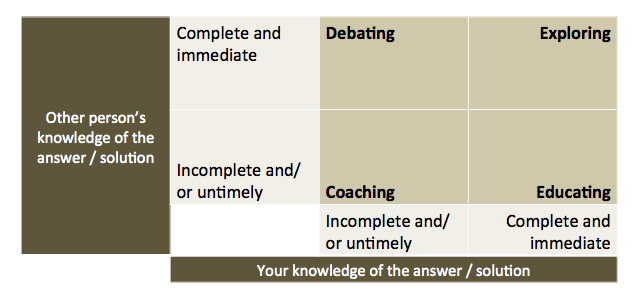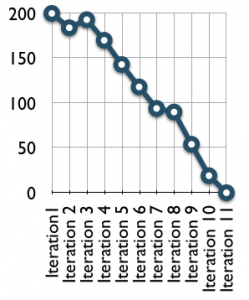I completed my 360 degree year end performance evaluation last week but this post is not about performance reviews. This post is the mental model I developed following a comment I received during the 360 degree discussions.
Martin, we recognize you are a good coach but as the president of the organization, we still expect you to act as a manager and take a position or make decisions instead of simply asking us questions.
As any other coach out there ever received similar feedback from the team they work with? In my opinion, this is recurring question asked to coaches.
Since defining what my role should be as the leader of a self-organized team, I’ve adapted my leadership style from traditional to coaching, with apparently good impact. Unfortunately, I may have pushed the coaching stance a little too much and need to adjust in order to meet the expectation of a leader.
The above statement and questions that followed in my head, led me to develop a mental model to determine which stance I could take in a conversation. The model also aims to help others who wish to be agile managers, and determine the right stance to take in different circumstances.
Two perspectives and two dimensions
Below is my mental model which takes into considerations both participants’ perspective on a specific situation – the other person’s (to the left) and yours (at the bottom).
Each of the two people either has a complete and immediate answer or solution to the situation at hand or an incomplete and/or untimely answer (which means the person is likely to find the complete answer after thinking about it for a while but the time frame is shorter than the allowed time. These two dimensions offer four possibilities or four quadrants.
Debating
In this situation, the other person already has the answer (or solution) to a specific situation while your knowledge of the topic is incomplete (or absent). Consequently, the only way you can actually contribute to the discussion is by improving the solution and by challenging the other person’s answer in an attempt to improve the answer or the outcome.
Coaching
In a situation when neither of the two participants know the answer to a specific situation, you can take a coaching stance. As such, asking clear questions in an attempt to help the other person come up by themselves with the answer to the situation. This stance allows the development of the individual as opposed to the improvement of the solution.
Educating
In the situation where you already know the answer but the other person doesn’t, you share the answer to the situation and explain how you got to the solution. The objective is to develop the skills of the other person so they may come up with their answer next time they are faced with a similar challenge. As with the coaching stance, acting as the educator focuses on the development of the individual which will eventually take you to the exploring stance.
Exploring
In this situation both parties already clearly know the answer to the situation and as such, a discussion takes place to explore all perspectives in an attempt to make sure the best options have been properly covered. As with the debating stance, the exploration aims at improving the quality of the idea since the individual already came up with the solution.
Using these four quadrants makes it easier to determine up front which position I will be taking in the conversation and allows me to be fully coherent from one discussion to the next.


 The content of the template is updated at the end of each Sprint. Below, the SunSet graph after 6 sprints.
The content of the template is updated at the end of each Sprint. Below, the SunSet graph after 6 sprints.
Recent Comments